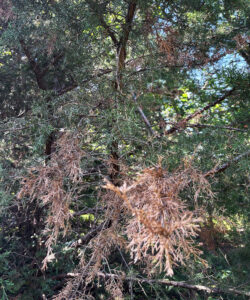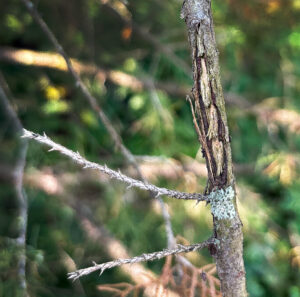
Dieback discovered on red cedar branches in Beloit (Rock County) in August 2025. / Photo Credit: Wisconsin DNR
By River Mathieu, DNR Forest Health Specialist, Fitchburg
River.Mathieu@wisconsin.gov or 608-772-2758
In August, random branch dieback was observed by a Wisconsin Department of Natural Resources forester on red cedars in a 10-acre stand near Beloit in Rock County.
At first, the pattern of dieback was perplexing. Based on a photograph, the damage was first presumed to be caused by a fungal disease. Once a site visit was conducted, it was determined that the branch dieback was caused by cicada oviposition (egg-laying) damage from last year’s emergence of periodical cicadas.
Southern Wisconsin experienced an emergence of 17-year Brood XIII cicadas in multiple localities in 2024. Branch flagging caused by oviposition (egg laying) by cicadas was apparent on trees at Big Foot Beach State Park and other areas in Walworth and Rock counties.

Oviposition damage from cicadas discovered on a red cedar twig in Beloit in August 2025. / Photo Credit: Wisconsin DNR
The cicadas from the 2024 mass emergence are gone, and another mass emergence is not expected until 2041. However, the branch flagging caused by cicadas ovipositing on hardwoods and conifers is still visible in some areas, such as on the red cedars observed in Beloit.
Last year, female cicadas oviposited in slits that they cut into the branches of various tree species. This killed branches or twigs but did not cause mortality of healthy, mature trees.
If you are in southern Wisconsin and noticed cicadas last year — and you see branch flagging on trees this year — check twigs and branches for the telltale slits formed by cicadas.
In the majority of cases, there is no need to take management action because the damage has already been done. Dead branches can be left alone. If desired, they can be removed after the first hard freeze in fall 2025 until the end of March 2026.
For more information on last year’s periodical cicada emergence, visit the University of Wisconsin-Madison Insect Diagnostic Lab’s Periodical Cicadas in Wisconsin webpage.
